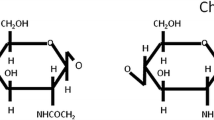Abstract
The Schiff bases of chitosan are synthesized by the reaction of chitosan with different aromatic aldehydes. The structures of the biopolymeric Schiff bases are characterized by Fourier transform infrared spectroscopy, 1H-NMR spectroscopy and elemental analysis (C, H, N). The 1H NMR spectroscopy is used to determine degree of deacetylation of chitosan and degree of substitution of Schiff bases. The Schiff base polymers have greater degrees of substitution varying from 65 to 88.5 %. Thermogravimetry of Schiff base polymers shows that they have nearly the same decomposition temperature as the chitosan, indicating that Schiff bases are thermally stable. The antimicrobial activities of chitosan and its Schiff bases are tested against Staphylococcus aureus, Bacillus subtilis, Escherichia coli and Aspergillus niger and found that the antimicrobial activities of the Schiff bases of chitosan were stronger than those of chitosan.






Similar content being viewed by others
References
Kurita K. Chemistry and application of chitin and chitosan. Polym Degrad Stab. 1998;59:117–20.
Prashanth KVH, Tharanathan RN. Chitin/chitosan: modifications and their unlimited application potential an overview. Trends Food Sci Technol. 2007;18:117–31.
Honarkar H, Barikani M. Applications of biopolymers I: chitosan. Monatsh Chem. 2009;140:1403–20.
Ravi Kumar MNV. A review of chitin and chitosan applications. React Funct Polym. 2000;46:1–27.
Rinaudo M, Pavlov G, Desbrieres P. Influence of acetic acid concentration on the solubilization of chitosan. Polymer. 1999;40:7029–32.
Yin X, Chen J, Yuan W, Lin Q, Ji L, Liu F. Preparation and antibacterial activity of Schiff bases from O-carboxymethyl chitosan and para-substituted benzaldehydes. Polym Bull. 2012;68:1215–26.
Tirkistani FAA. Thermal analysis of some chitosan Schiff bases. Polym Degrad Stab. 1998;60:67–70.
Dos Santos JE, Dockal ER, Cavalheiro ETG. Synthesis and characterization of Schiff bases from chitosan. Carbohydr Polym. 2005;60:277–82.
Pereira FS, Agostini DLS, Job AE, GonzálezJiao ERP. Thermal studies of chitin–chitosan derivatives. J Therm Anal Calorim. 2013;114:321–7.
Cimerman Z, Galic N, Bosner B. The Schiff bases of salicylaldehyde and aminopyridines as highly sensitive analytical reagents. Anal Chim Acta. 1997;343:145–53.
Dos Santos JE, Dockal ER, Cavalheiro ETG. Thermal behavior of Schiff base from chitosan. J Therm Anal Calorim. 2005;79:243–8.
Kurita K, Mori S, Nishiyama Y, Harata M. N-alkylation of chitin and some characteristics of the novel derivatives. Polym Bull. 2002;48:159–66.
Arora S, Lal S, Kumar S, Kumar M, Kumar M. Comparative degradation kinetic studies of three biopolymers: chitin, chitosan and cellulose. Arch Appl Sci Res. 2011;3(3):188–201.
Aneja KR, Sharma C, Joshi R. Fungal infection of ear: a common problem in north eastern part of Haryana. Inter J Otorhinolaryngol. 2010;74:604–7.
Ahmad I, Beg AJ. Antimicrobial and phytochemical studies on 45 Indian medicinal plants against multidrug resistant human pathogens. J Ethnopharmacol. 2001;74:113–23.
Andrews JM. Determination of minimum inhibitory concentrations. J Antimicrob Chemother. 2001;48:5–16.
Al-Burtamani SKS, Fatope MO, Marwah RG, Onifade AK, Al-Saidi SH. Chemical composition, antibacterial and antifungal activities of the essential oil of Haplophyllum tuberculatum from Oman. J Ethnopharmocol. 2005;96:107–12.
Jin X, Wang J, Bai J. Synthesis and antimicrobial activity of the Schiff base from chitosan and citral. Carbohyd Res. 2009;344:825–9.
Colthup NB, Daly LH, Wiberley SE. Introduction to infrared and Raman spectroscopy. 3rd ed. San Diego: Academic Press; 1990.
Silverstein RM, Bassler GC, Morrill TC. Spectrometric identification of organic compounds. 5th ed. New York: Wiley; 1991.
Pawlak A, Mucha M. Thermogravimetric and FTIR studies of chitosan blends. Thermochim Acta. 2003;396:153–66.
Tsai GJ, Su WH. Antibacterial activity of shrimp chitosan against Escherichia coli. J Food Prot. 1999;62:239–43.
Hwang JK, Kim HJ, Yoon SJ, Pyun YR. Bactericidal activity of chitosan on E. coli. In: Chen RH, Chen HC, editors. Advances in chitin science, vol. III. Taiwan: Rita Advertising; 1998. p. 340–4.
Acknowledgements
One of the authors, Sohan Lal, is extremely thankful to the Council of Scientific and Industrial Research and University Grant Commission, New Delhi, India, for providing the research grant.
Author information
Authors and Affiliations
Corresponding author
Rights and permissions
About this article
Cite this article
Lal, S., Arora, S. & Sharma, C. Synthesis, thermal and antimicrobial studies of some Schiff bases of chitosan. J Therm Anal Calorim 124, 909–916 (2016). https://doi.org/10.1007/s10973-015-5227-3
Received:
Accepted:
Published:
Issue Date:
DOI: https://doi.org/10.1007/s10973-015-5227-3




